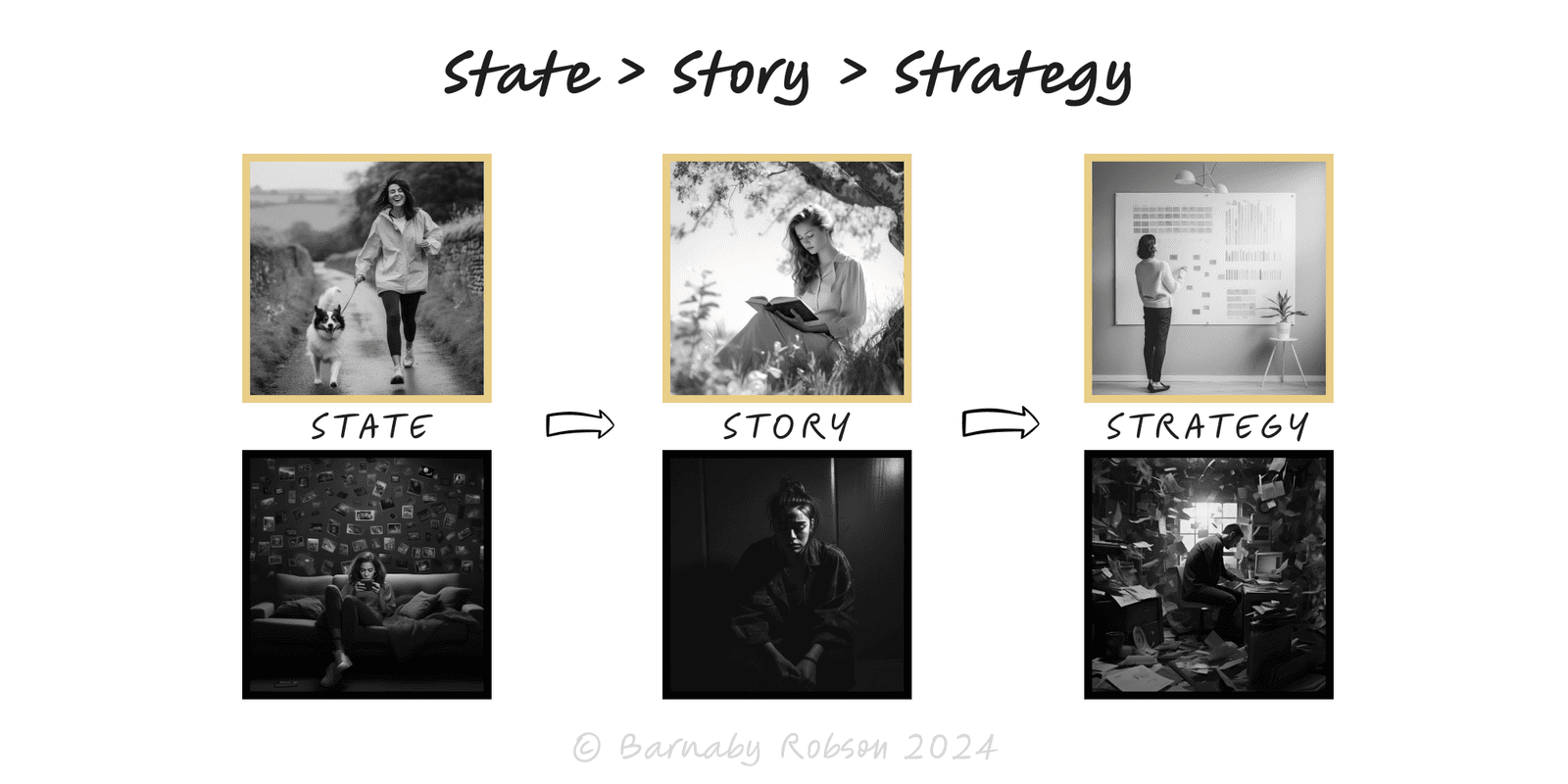State, Story, Strategy
Align your State (how you show up), your Story (the narrative you choose), and your Strategy (the plan). Start with state, or the best strategy won’t stick.
author
Popularised by Tony Robbins; used by Tim Ferriss
Model type

About
This is a practical sequencing heuristic. Begin by shifting your state so you have access to resourceful emotion and attention. From that state, craft an enabling story about what is controllable and worth doing. Only then choose strategy and act. The order matters.
How it works
STATE – your mental and emotional condition. Two poles: Powerful state: proactive, problem-solving, ownership.
Victim state: passive, externally controlled, excuse-seeking.
Common levers:
Sleep/rest – target ≥ 7 hours; anchor bedtime to wake time.
Physiology – move, sunlight, posture; “mood follows action”.
Gut/energy – simple, balanced food that supports sleep and focus.
Music – playlists that reliably shift arousal and focus.
“I wanted to go on offensive… focus, learn, build, and invest in relationships…”
— Chris Sacca
STORY – the narrative you tell yourself about the situation. Enabling story (powerful state): acknowledges obstacles, highlights control, proposes action.
Disabling story (victim state): essentialises limits (“I’m just…”) and removes agency.
STRATEGY – the plan and commitments. Defined by present facts, controllable levers, options, and a bias to act.
Fails without the right state/story, even if logically sound.
Victim state: passive, externally controlled, excuse-seeking.
Common levers:
Sleep/rest – target ≥ 7 hours; anchor bedtime to wake time.
Physiology – move, sunlight, posture; “mood follows action”.
Gut/energy – simple, balanced food that supports sleep and focus.
Music – playlists that reliably shift arousal and focus.
“I wanted to go on offensive… focus, learn, build, and invest in relationships…”
— Chris Sacca
STORY – the narrative you tell yourself about the situation. Enabling story (powerful state): acknowledges obstacles, highlights control, proposes action.
Disabling story (victim state): essentialises limits (“I’m just…”) and removes agency.
STRATEGY – the plan and commitments. Defined by present facts, controllable levers, options, and a bias to act.
Fails without the right state/story, even if logically sound.
Use cases
Daily execution – journal header “State → Story → Strategy” to anchor focus.
Coaching/1:1s – shift state first, then reframe the story, then co-design strategy.
Negotiations & stakeholder comms – regulate state to avoid second-arrow spirals, craft story, propose options.
Turnarounds – rebuild team state (wins, cadence), re-author the narrative, then lock the playbook.
Coaching/1:1s – shift state first, then reframe the story, then co-design strategy.
Negotiations & stakeholder comms – regulate state to avoid second-arrow spirals, craft story, propose options.
Turnarounds – rebuild team state (wins, cadence), re-author the narrative, then lock the playbook.
How to apply
State – 3–5 minute reset (breath, posture, quick walk, music). Name the current state.
Story – write one enabling paragraph: what’s controllable, what matters now.
Strategy – list 3 actions with owners and deadlines; choose the first reversible step.
Act – do the first step immediately; schedule the others.
Review – end of day: state shift worked? story held? strategy progressed?
Story – write one enabling paragraph: what’s controllable, what matters now.
Strategy – list 3 actions with owners and deadlines; choose the first reversible step.
Act – do the first step immediately; schedule the others.
Review – end of day: state shift worked? story held? strategy progressed?
pitfalls and cautions
Skipping the state work – trying to “think” your way out while in a low state.
Pretty stories – narratives with no controllable next actions.
Strategy theatre – plans not tied to owners, dates, and a first move.
Pretty stories – narratives with no controllable next actions.
Strategy theatre – plans not tied to owners, dates, and a first move.
